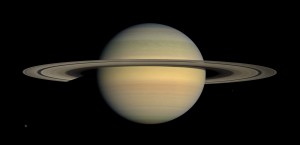1. Saturn is the sixth planet from the Sun and the second largest.
2. Saturn was the god of agriculture in Roman mythology. Saturn is also the father of Jupiter, the king of the Roman gods.
3. Saturn is flattened at the poles, due to a fast rotation on its axis.
4. Saturn has 62 known moons, fifty-three have been named. Most of them are small in size.
5. Names of some of Saturn’s moons: the largest is Titan, discovered in 1655; Tethys, Dione, Rhea, & Iapetus, discovered from 1671 to 1672; Mimas & Enceladus, discovered in 1789; and Hyperion, discovered in 1848.
6. A year on Saturn is equal to 29.5 Earth Years.
7. Saturn is the only planet in our solar system that is less dense that water. This means that it would float if there was a body of water large enough to hold it.
8. A day on Saturn is equal to 10 hours and 14 minutes in Earth days.
9. Diameter of Saturn is 119,871 km (74,500 miles).
10. Saturn’s maximum distance from the Sun is 1.5 billion km (938 million miles).
11. Saturn’s minimum distance from Earth is 1.2 billion km (746 million miles).
12. Saturn has fourteen subdivisions of its rings, the widest is at 25,500 km, the B ring.
13. Saturn’s rings are made primarily of “water ice” mixed with dust and other chemicals.
14. Saturn’s fame has been observed going back to ancient times, the Babylonians, Romans, Greek, Hindus, and many more ancient civilizations have taken great interest in studying this ringed planet.
15. If you weigh 100 lbs, your weight on Saturn would be 108 lbs. (multiply your actual weight by 1.08).
16. The temperature on Saturn by the clouds is at -274° F.
17. Titan is Saturn's only moon that has an atmosphere, it is also bigger than Mercury.
18. The first astronomer to make note of Saturn's rings was Galileo, although his telescope was not powerful enough and he thought that the rings were actually satellites.
19. Saturn's rings are made of water, ice, rocks, dust and other chemicals.
20. Pioneer 11 did the first flyby of the planet in 1979. Since then, Voyager 1 was sent closer to Saturn and it took much higher quality photographs.
21. In 2004 the Cassini-Huygens space probe entered into orbit around Saturn and also took vivid photos of some of the planet's moons.
22. The day of the week, Saturday, is named after Saturn.

